Griffiths D. Head First Statistics
Подождите немного. Документ загружается.

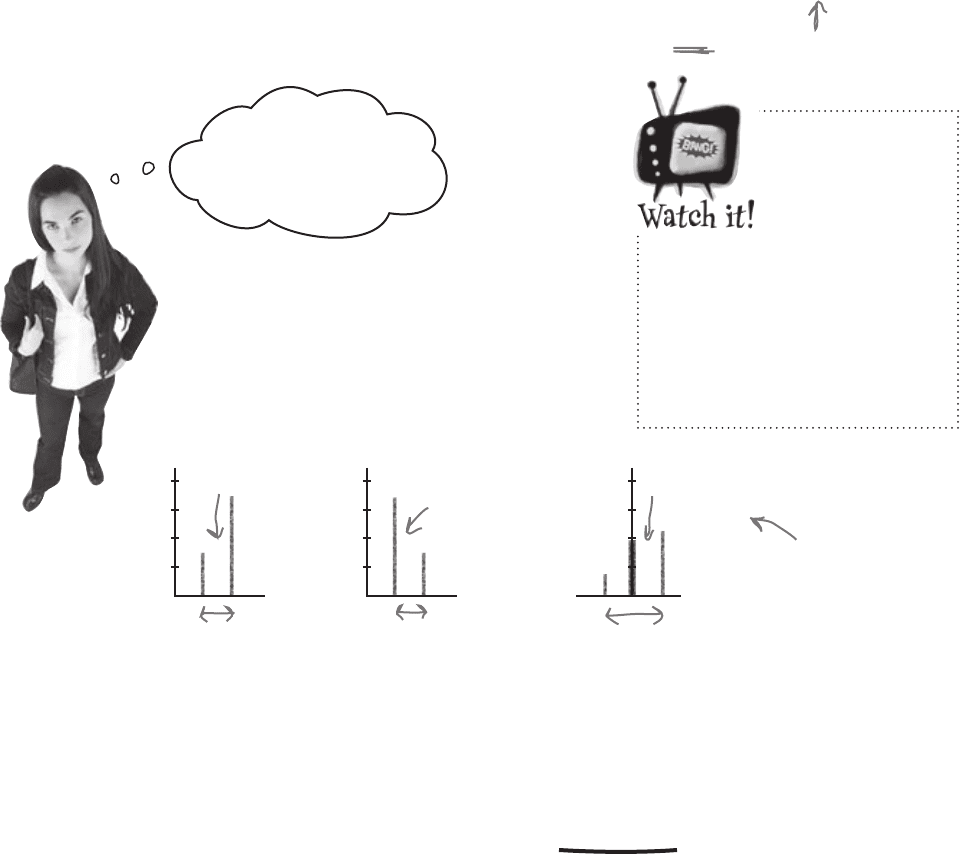
you are here 4 231
using discrete probability distributions
You’re not just limited to adding random variables; you
can also subtract one from the other. Instead of using the
probability distribution of X + Y, we can use X – Y.
If you’re dealing with the difference between two random
variables, it’s easy to find the expectation. To find E(X – Y),
we subtract E(Y) from E(X).
Finding the variance of X – Y is less intuitive. To find
Var(X – Y), we add the two variances together.
E(X - Y) = E(X) – E(Y)
Var(X - Y) = Var(X) + Var(Y)
But that doesn’t make
sense. Why should we
add the variances?
Because the variability increases.
When we subtract one random variable
from another, the variance of the probability
distribution still increases.
When we subtract independent random variables, the
variance is exactly the same as if we’d added them together.
The amount of variability can only increase.
If you’re
subtracting
two random
variables, add
the variances.
It’s easy to make this
mistake as at first glance it
seems counterintuitive. Just
remember that if the two
variables are independent,
Var(X - Y) = Var(X) + Var(Y)
We add the variances, so be careful!
The variance increases,
even though we’re
subtracting variables.
E(X)
E(Y)
Var(X)
Var(Y)
-
0 0
E(X - Y)
Var(X - Y)
=
Subtracting independent
random variables still
increases the variance.
…and subtract E(X) and E(Y) to get E(X – Y)
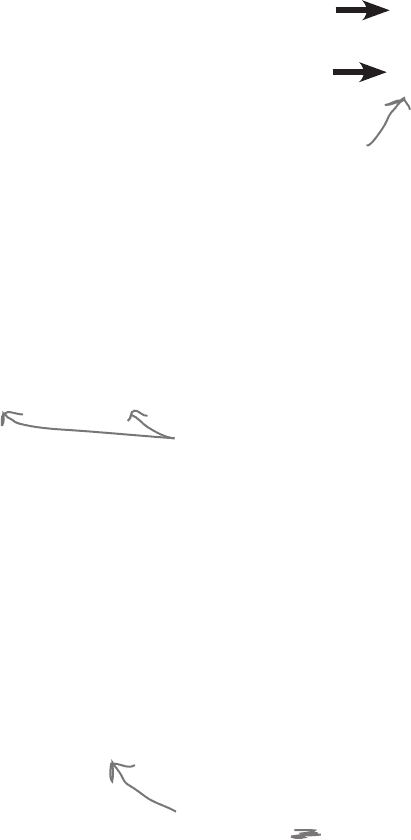
232 Chapter 5
It doesn’t stop there. As well as adding and subtracting random variables,
we can also add and subtract their linear transforms.
Imagine what would happen if Fat Dan changed the cost and prizes on both
machines, or even just one of them. The last thing we’d want to do is work
out the entire probability distribution in order to find the new expectations
and variances.
Fortunately, we can take another shortcut.
Suppose the gains on the X and Y slot machines are changed so that the
gains for X become aX, and the gains for Y become bY. a and b can be any
number.
X
Y
aX
bY
To find the expectation and variance for combinations of aX and bY,
we can use the following shortcuts.
E(aX + bY) = aE(X) + bE(Y)
Var(aX + bY) = a
2
Var(X) + b
2
Var(Y)
Adding aX and bY
If we want to find the expectation and variance of
aX + bY, we use
Subtracting aX and bY
If we subtract the random variables and calculate
E(aX - bY) and Var(aX - bY), we use
E(aX - bY) = aE(X) - bE(Y)
Var(aX - bY) = a
2
Var(X) + b
2
Var(Y)
It’s a linear transform, so
we square the numbers here.
Just as before, we add the variances, even though
we’re subtracting the random variables.
Remember to add the variances.
We square the numbers because it’s a linear
transform, just like before.
a and b can be any number.
You can also add and subtract linear transformations
adding and subtracting linear transformations

you are here 4 233
using discrete probability distributions
Q:
So if X and Y are games, does
aX + bY mean a games of X and b games
of Y?
A: aX + bY actually refers to two linear
transforms added together. In other words,
the underlying values of X and Y are
changed. This is different from independent
observations, where each game would be an
independent observation.
Q:
I can’t see when I’d ever want to
use X – Y. Does it have a purpose?
A: X – Y is really useful if you want to find
the difference between two variables.
E(X – Y) is a bit like saying “What do you
expect the difference between X and Y to
be”, and Var(X – Y) tells you the variance.
Q:
Why do you add the variances for
X – Y? Surely you’d subtract them?
A: At first it sounds counterintuitive,
but when you subtract one variable from
another, you actually increase the amount
of variability, and so the variance increases.
The variability of subtracting a variable is
actually the same as adding it.
Another way of thinking of it is that
calculating the variance squares the
underlying values. Var(X + bY) is equal to
Var(X) + b
2
Var(Y), and if b is -1, this gives us
Var(X - Y). As (-1)
2
= 1, this means that
Var(X - Y) = Var(X) + Var(Y).
Q:
Can we do this if X and Y aren’t
independent?
A: No, these rules only apply if X and
Y are independent. If you need to find the
variance of X + Y where there’s dependence,
you’ll have to calculate the probability
distribution from scratch.
Q:
It looks like the same rules apply
for X + Y as X
1
+ X
2
. Is this correct?
A: Yes, that’s right, as long as X, Y, X
1
and X
2
are all independent.
Independent observations of X are different instances
of X. Each observation has the same probability
distribution, but the outcomes can be different.
If X
1
, X
2
, ..., X
n
are independent observations of X then:
E(X
1
+ X
2
+ ... + X
n
) = nE(X)
Var(X
1
+ X
2
+ ... X
n
) = nVar(X)
If X and Y are independent random variables, then:
E(X + Y) = E(X) + E(Y)
E(X - Y) = E(X) - E(Y)
Var(X + Y) = Var(X) + Var(Y)
Var(X - Y) = Var(X) + Var(Y)
The expectation and variance of linear transforms of X
and Y are given by
E(aX + bY) = aE(X) + bE(Y)
E(aX - bY) = aE(X) - bE(Y)
Var(aX + bY) = a2Var(X) + b2Var(Y)
Var(aX - bY) = a2Var(X) + b2Var(Y)

234 Chapter 5
Below you’ll see a table containing expectations and variances. Write the formula or shortcut for
each one in the table. Where applicable, assume variables are independent.
Statistic Shortcut or formula
E(aX + b)
Var(aX + b)
E(X)
E(f(X))
Var(aX - bY)
Var(X)
E(aX - bY)
E(X
1
+ X
2
+ X
3
)
Var(X
1
+ X
2
+ X
3
)
E(X
2
)
Var(aX - b)
expectation and variance exercises
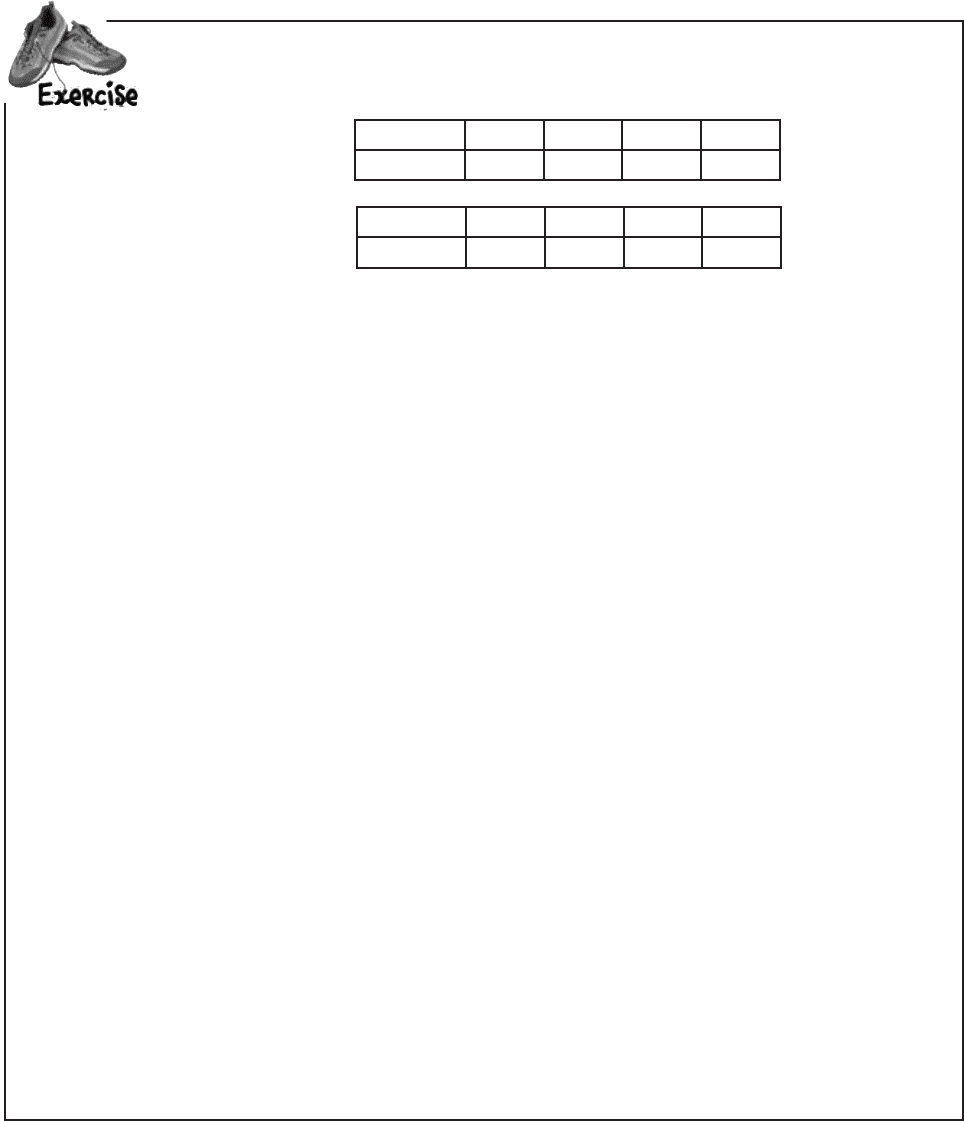
you are here 4 235
using discrete probability distributions
A restaurant offers two menus, one for weekdays and the other for weekends. Each menu offers
four set prices, and the probability distributions for the amount someone pays is as follows:
x 10 15 20 25
P(X = x)
0.2 0.5 0.2 0.1
Weekday:
y 15 20 25 30
P(Y = y)
0.15 0.6 0.2 0.05
Weekend:
Who would you expect to pay the restaurant most: a group of 20 eating at the weekend, or a
group of 25 eating on a weekday?

236 Chapter 5
Below you’ll see a table containing expectations and variances. Write the formula or shortcut for
each one in the table. Where applicable, assume variables are independent.
Statistic Shortcut or formula
E(aX + b)
aE(X) + b
Var(aX + b)
a
2
Var(X)
E(X)
xP(X = x)
E(f(X))
f(x)P(X = x)
Var(aX - bY)
a
2
Var(X) + b
2
Var(Y)
Var(X)
E(X - μ)
2
= E(X
2
) - μ
2
E(aX - bY)
aE(X) - bE(Y)
E(X
1
+ X
2
+ X
3
)
3E(X)
Var(X
1
+ X
2
+ X
3
)
3Var(X)
E(X
2
)
x
2
P(X = x)
Var(aX - b)
a
2
Var(X)
exercise solutions
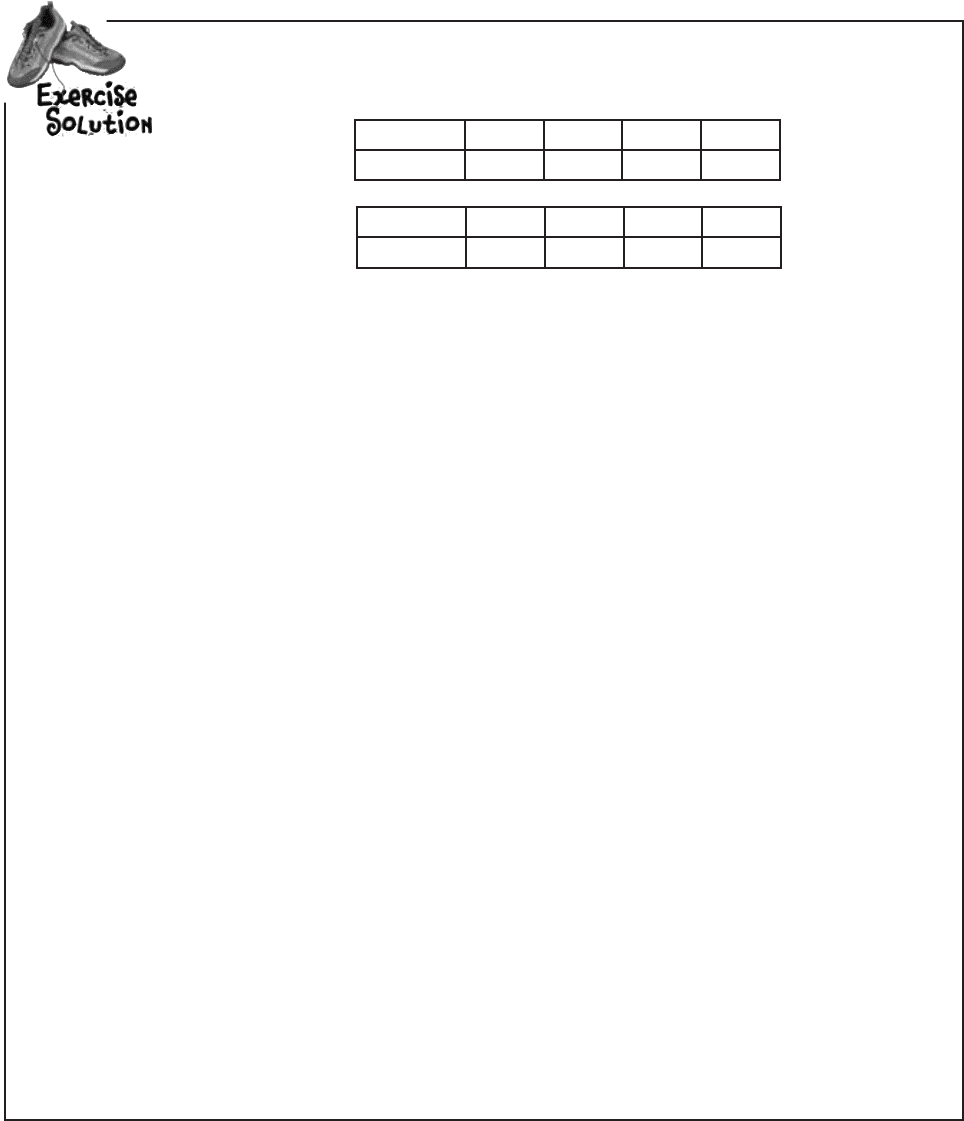
you are here 4 237
using discrete probability distributions
A restaurant offers two menus, one for weekdays and the other for weekends. Each menu offers
four set prices, and the probability distributions for the amount someone pays is as follows:
x 10 15 20 25
P(X = x)
0.2 0.5 0.2 0.1
Weekday:
y 15 20 25 30
P(Y = y)
0.15 0.6 0.2 0.05
Weekend:
Who would you expect to pay the restaurant most: a group of 20 eating at the weekend, or a
group of 25 eating on a weekday?
Let’s start by finding the expectation of a weekday and a weekend. X represents
someone paying on a weekday, and Y represents someone paying at the weekend.
E(X) = 10x0.2 + 15x0.5 + 20x0.2 + 25x0.1
= 2 + 7.5 + 4 + 2.5
= 16
E(Y) = 15x0.15 + 20x0.6 + 25x0.2 + 30x0.05
= 2.25 + 12 + 5 + 1.5
= 20.75
Each person eating at the restaurant is an independent observation, and to find the
amount spent by each group, we multiply the expectation by the number in each group.
25 people eating on a weekday gives us 25xE(X) = 25x16 = 400
20 people eating at the weekend gives us 20xE(Y) = 20x20.75 = 415
This means we can expect 20 people eating at the weekend to pay more than 25
people eating on a weekday.

238 Chapter 5
Jackpot!
You’ve covered a lot of ground in
this chapter. You learned how to use
probability distributions, expectation,
and variance to predict how much you
stand to win by playing a specific slot
machine.
And you discovered how to use
linear transforms and independent
observations to anticipate how much
you’ll win when the payout structure
changes or when you play multiple
games on the same machine.
you’re an expectation expert!
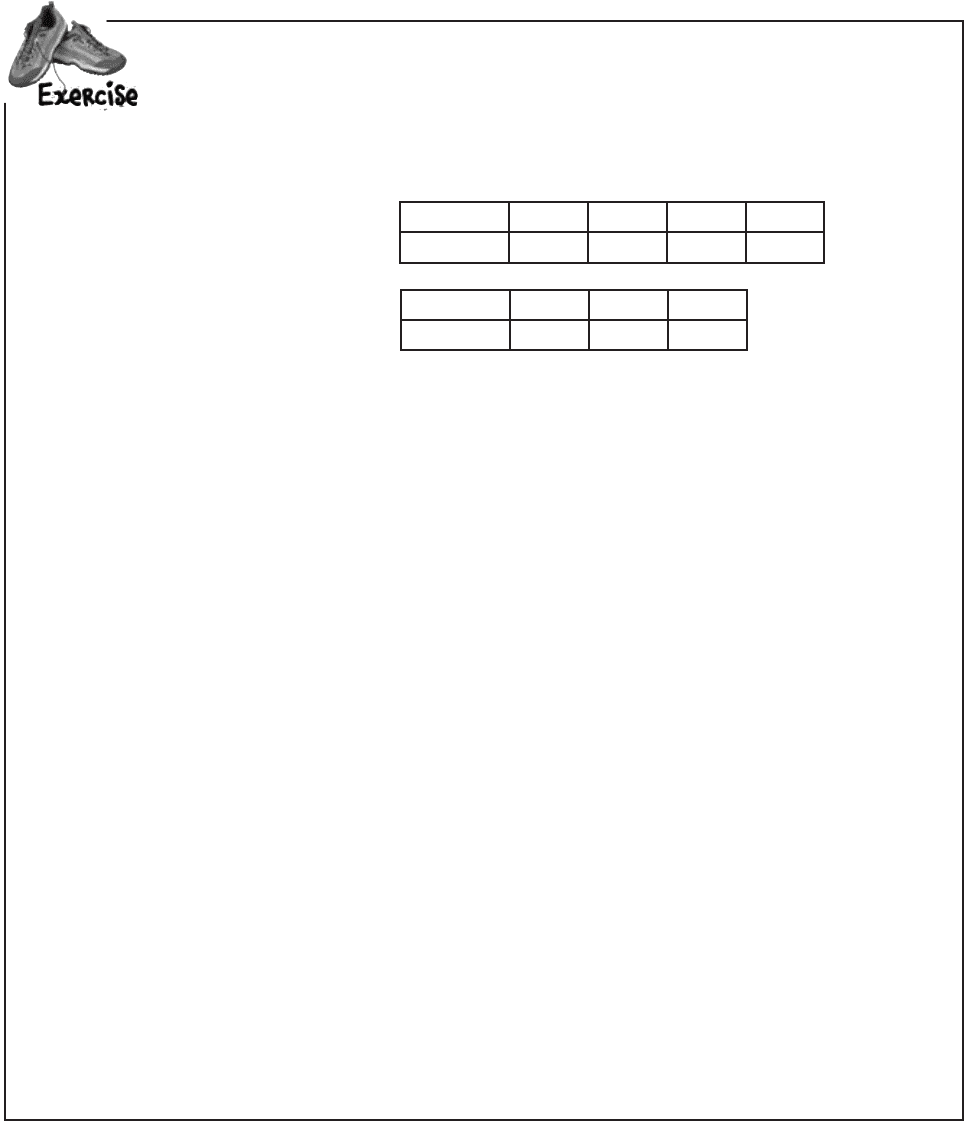
you are here 4 239
using discrete probability distributions
Sam likes to eat out at two restaurants. Restaurant A is generally more expensive than
restaurant B, but the food quality is generally much better.
Below you’ll find two probability distributions detailing how much Sam tends to spend at each
restaurant. As a general rule, what would you say is the difference in price between the two
restaurants? What’s the variance of this?
x 20 30 40 45
P(X = x)
0.3 0.4 0.2 0.1
Restaurant A:
y 10 15 18
P(Y = y)
0.2 0.6 0.2
Restaurant B:
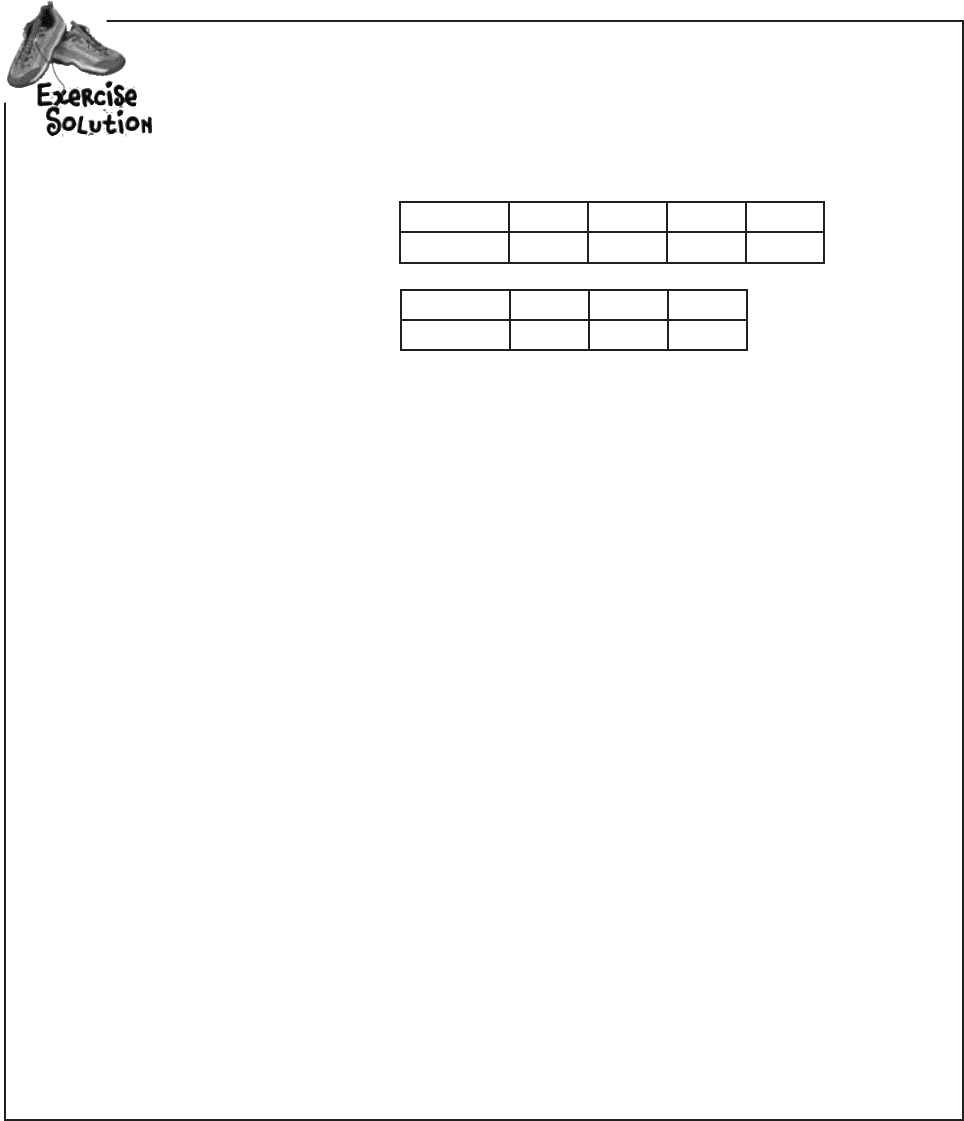
240 Chapter 5
Let’s start by finding the expectation and variance of X and Y.
E(X) = 20x0.3 + 30x0.4 + 40x0.2 + 45x0.1
= 6 + 12 + 8 + 4.5
= 30.5
Var(X) = (20-30.5)
2
x0.3 + (30-30.5)
2
x0.4 +
(40-30.5)
2
x0.2 + (45-30.5)
2
x0.1
= (-10.5)
2
x0.3 + (-0.5)
2
x0.4 + 9.5
2
x0.2 + 14.5
2
x0.1
= 110.25x0.3 + 0.25x0.4 + 90.25x0.2 + 210.25x0.1
= 33.075 + 0.1 + 18.05 + 21.025
= 72.25
E(Y) = 10x0.2 + 15x0.6 + 18x0.2
= 2 + 9 + 3.6
= 14.6
Var(Y) = (10-14.6)
2
x0.2 + (15-14.6)
2
x0.6 +
(18-14.6)
2
x0.2
= (-4.6)
2
x0.2 + 0.4
2
x0.6 + 3.4
2
x0.2
= 21.16x0.2 + 0.16x0.6 + 11.56x0.2
= 4.232 + 0.096 + 2.312
= 6.64
The difference between X and Y is modeled by X - Y.
E(X - Y) = E(X) - E(Y)
= 30.5 - 14.6
= 15.9
Var(X - Y) = Var(X) + Var(Y)
= 72.25 + 6.64
= 78.89
Sam likes to eat out at two restaurants. Restaurant A is generally more expensive than
restaurant B, but the food quality is generally much better.
Below you’ll find two probability distributions detailing how much Sam tends to spend at each
restaurant. As a general rule, what would you say is the difference in price between the two
restaurants? What’s the variance of this?
x 20 30 40 45
P(X = x)
0.3 0.4 0.2 0.1
Restaurant A:
y 10 15 18
P(Y = y)
0.2 0.6 0.2
Restaurant B:
exercise solution
